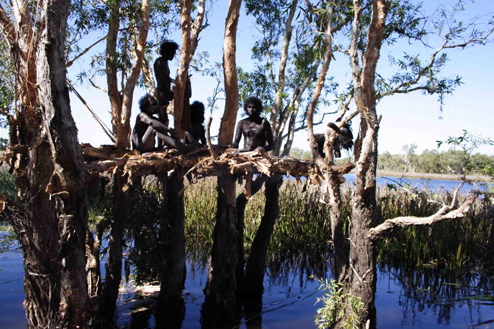[Photo by Jackson, Courtesy of Fandango Australia and Vertigo Productions.]
I watched the film Ten Canoes the other night. In the opening shots of the film the camera pans over the Arnhemland wetlands, that part of Australia where one third of our bird species live. One instinctively holds one’s eyes wide open to this expansive, green, bird-buzzing, wilderness. The film turns out to be a story told by a canny and humorous old Aboriginal, set in the time of his ancestors. The film follows a tribe who go through revenge, love, battle, laughter and gathering goose eggs on a swamp, among other things. In the above photo the hunting men avoid crocodiles by camping high in the branches of paperbark trees. It was nice to see a film where the pace and rhythm of life is slow, closer to the daily schedule of the natural world than in most other films. The camera shots often make humans tramping through the landscape look peripheral to the enduring and greater fact of the earth, positioning them at the top edge of the frame for example. And to see bark canoes made with precision and paperbark stripped to carry food and make shelter is to witness important local competencies. So many folkways have been lost with the loss of Aboriginal culture, and indeed some amount of cultural revival had to take place in the making of this film. The first Australians were truly the mastercraftsman of living in the bush. This film acknowledges that fact with quiet accuracy. Although I admire this original Aboriginal culture, I am personally searching for a whitefella dreaming. We white Australians also need representative stories, or cultural myths, which illustrate our living sustainably with the land.
